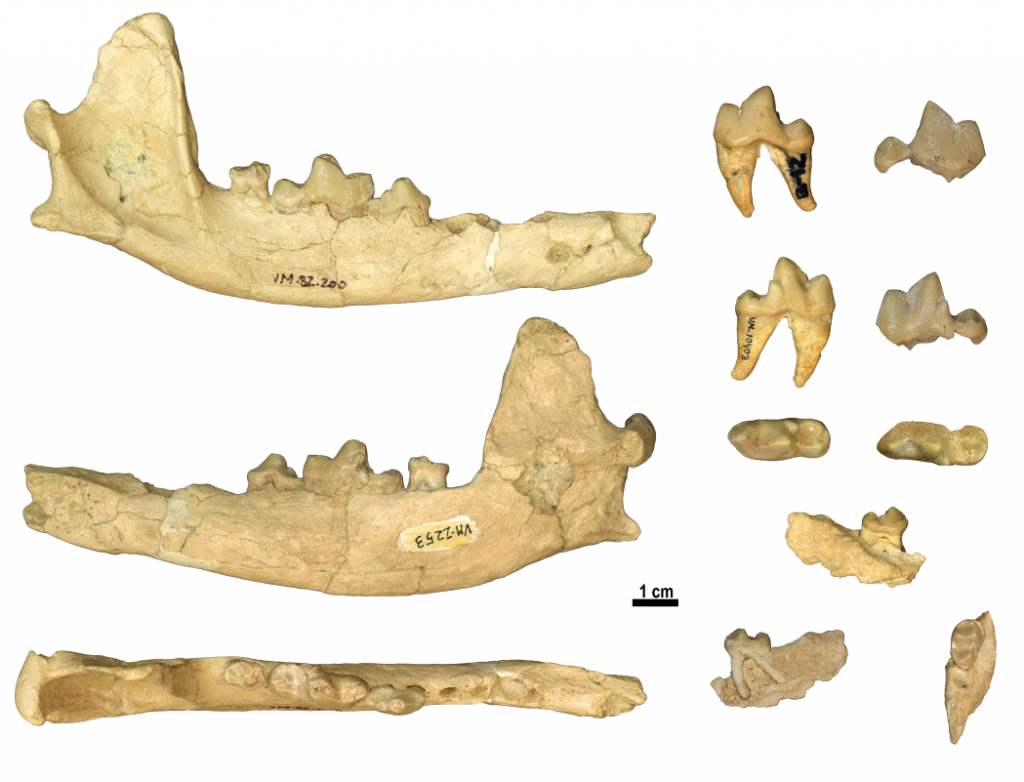28/04/2021
A new fossil species of small wolf, dated 1.6 million-years-old, is found at the sites of Orce, southern Spain
Its name, Canis orcensis, is dedicated to the Andalusian town where it has been found

Its name, Canis orcensis, is dedicated to the Andalusian town where it has been found
The site of Venta Micena, located in Orce (Baza basin, Granada), dated 1.6 million-years-old, preserves one of the best paleontological records of large Quaternary mammals in Europe and the world. It was found 45 years ago by a team from the Institute of Paleontology Miquel Crusafont, led by Prof. Josep Gibert. Since then, Orce has become one of the world benchmarks of Paleontology and Prehistory. The reason is that the earliest evidences of human presence in Western Europe are there, located at the sites of Barranco León and Fuente Nueva 3, dated at 1.4 and 1.3 million-years-old, consisting of a fossil human tooth, abundant lithic artefacts, and cut and fracture marks on the fossil bones left by the use of the stone tools for feeding the carcasses of large mammals.
Venta Micena, Orce and all the Baza basin continue providing new interesting findings. In this context, a team of paleontologists led by Bienvenido Martínez-Navarro, ICREA researcher at the Institut Català de Paleoecologia Humana i Evolució Social (IPHES-CERCA) and contracted professor at the Universitat Rovira i Virgili (URV), have described a new species of small wolf, of 15-20 kg of bodyweight, dated 1.6 million-years-old. Its name is Canis orcensis, in homage to the town of Orce.
The discovery was announced today in a paper published in the journal Comptes Rendus Palevol. Together with Bienvenido Martínez-Navarro, the other authors are Saverio Bartolini Lucenti from the University of Florence; Mª Patrocinio Espigares, Sergio Ros-Montoya and Paul Palmqvist, from the University of Malaga, and Joan Madurell-Malapeira, from the Institut Català de Paleontologia (ICP).

This team has reinterpreted all the fossil remains of the site corresponding to the genus Canis, verifying that their anatomical and metric data differ from the classic records of the species Canis etruscus, described in 1877 in Italy, and are more closely related to those of the later species, Canis mosbachensis, described in 1925 at the site of Mosbach in Germany, and also recorded in Barranco León and Fuente Nueva 3, the latter two in Orce. “The new species identified in Venta Micena is different -says Bienvenido Martínez-Navarro-, it is characterized by a dentition with a tendency to hypercarnivory, which indicates that it consumed more meat from vertebrates than other similar middle-sized Pleistocene canids, whose dietary habits were more omnivorous, with higher consumption of vegetables”.
This conclusion, based on the comparative study of its craniodental morphology, “is also supported by geochemical evidence, such as the abundance of stable nitrogen isotopes in fossils, which indicate quite carnivorous habits for this little wolf”, says the same paleontologist from IPHES. Venta Micena is a paleontological site with unique dimensions. It is a fertile horizontal level one meter thick, which can be followed on the surface for 2.5 km. It has been calculated that it has more than 1 km2 with fossils, that is, more than a million m2 with paleontological remains, with an average record of more than 60 fossils per m2. “It is probably the richest paleontological site of the Quaternary in the world. For this reason, it has become one of the most studied localities in the continent”, says Bienvenido Martínez-Navarro.
Its record of large fossil mammals is very diverse, with an abundance of mammoths, rhinos, horses, hippos, large and small deer, two species of buffalos and four species of smaller bovids, together with a very spectacular variety of carnivores, that include two species of saber-toothed tigers, a panther and a lynx, among the felids, a giant hyena, the famous Pachycrocuta brevirostris, a bear, a badger and three species of canids, which include a fox, a lycaon and the small wolf Canis orcensis. To this must be added two species of rabbits, five of rodents, some insectivores (shrews) and other vertebrates, among them some scarce remains of aquatic birds.
“Thanks to this extraordinary quantity of fossils, countless studies of great international scientific projection on taxonomy, taphonomy, biogeochemistry, ecology, etc., have been carried out”, remarks the ICREA paleontologist from IPHES-CERCA and URV.
Article Martínez-Navarro B., Bartolini Lucenti S., Palmqvist P., Ros-Montoya S., Madurell-Malapeira J. & Espigares M. P. 2021. A new species of dog from the Early Pleistocene site of Venta Micena (Orce, Baza Basin, Spain). Comptes Rendus Palevol 20 (17): 297-314.
